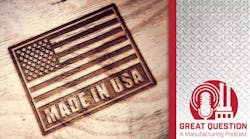All over the media, we regularly hear the word "fake" applied to news and information. Particularly in the
political sphere.
Today, I want to talk about how fake news creeps into the world of manufacturing. And the rabbit holes it can lead us down.
What is measurement, really?
Even a calculation as simple as an average can be misinterpreted. There’s the mean: sum of values divided by number of values. But the median is also called the average, and can be as meaningful. Then there’s the weighted average, which…my point being, measurements can lead to misunderstandings.
In manufacturing we talk about accuracy—how close a value is to true. And precision—how close to the mean.
Plus, uncertainty! You might uncertainty in a drinking-water analysis illustrated by the +/-. That’s the degree of uncertainty.
Measuring a tabletop with a ruler whose smallest marking is a ¼-inch? Then 1/8-inch is your degree of uncertainty; you could be off by as much as 1/8-inch.
To put it another way, if you’re dieting, you might weigh your serving of mashed potatoes on a kitchen scale. You wouldn’t put your dinner on the passenger seat of your Mack truck, head to a truckway stop for a measurement, and subtract the weight of you and the truck, in order to learn that your serving weighs 4.6 ounces, +/- 100 pounds.
No precision can be greater than the precision of the process. More on this one in a moment.
Watch out for those decimal places
Decimal places are the perfect breeding ground for fake news. They can imply a precision that may not exist. Let’s talk about an example you’re likely to have seen many times.
Say we have a continuous process measured in gallons-per-minute. The flow meter has a stated precision of +/- 10 gallons per minute—and hasn’t been calibrated since it was installed. A waste stream is measured, once a shift, by a field tech with a five-gallon bucket and a stopwatch.
Sound familiar?
Originally the waste report for this was a manual affair. In our example, let’s say the average was five gallons waste per ton of process for both shifts.
But now, a new MES has been implemented. And all values are reported to three decimal places. Note: no change to the measuring process or devices.
So, the new report averages 5.123 for shift A and 5.008 for shift B. Uh oh. Shift A is underperforming, costing us profit. Right?
Not so fast! We must consider where this new-found precision is coming from. The MES doesn’t supply it. The flow meter hasn’t changed. The field tech hasn’t suddenly gained Superman vision.
In fact, analytically, nothing has changed. The uncertainty is still at best +/- 10 gallons at the flow meter, and some unknown amount with the field tech.
But Company XYZ has just spent a lot of money on their implementation. They need to show a return on the investment. The new report seems to show a way to do so. They may dive on this "information," eager to address the new issue. But it’s not real. It’s fake precision. Paving the way for misguided decisions and actions.
Precision can be increased only by upgrading the precision of your measurements
For greater precision, you need more precise measurements.
Unfortunately, that requires more investment. In the field, there’s a general unawareness of how precision is attained. At Factora, we often find ourselves explaining that the next step may be to address the measuring process, rather than haring off after a calculation that looks more meaningful than it is. As partners and integrators, our role is to present data with the correct degree of uncertainty.
Want an example? One of our programmers originally used a customer-supplied data type in a calculation, and ended up with a result of “300 lb/hour over the course of a day.” But he quickly realized that the measuring process wasn’t precise enough to supply a lb/hour figure. The highest-possible precision was in 100-lbs per day. The “300 lb/hour” was fake news.
Summary
How do you prevent the spread of fake precision? Beware of any measurement you are presented with that’s being used to justify a course of action.
You must ask where did the numbers came from. From what process? From what tools?
Doing that will surely save yourself some dives down rabbit holes.
Kirby Knight is a senior MES consultant at Factora.


